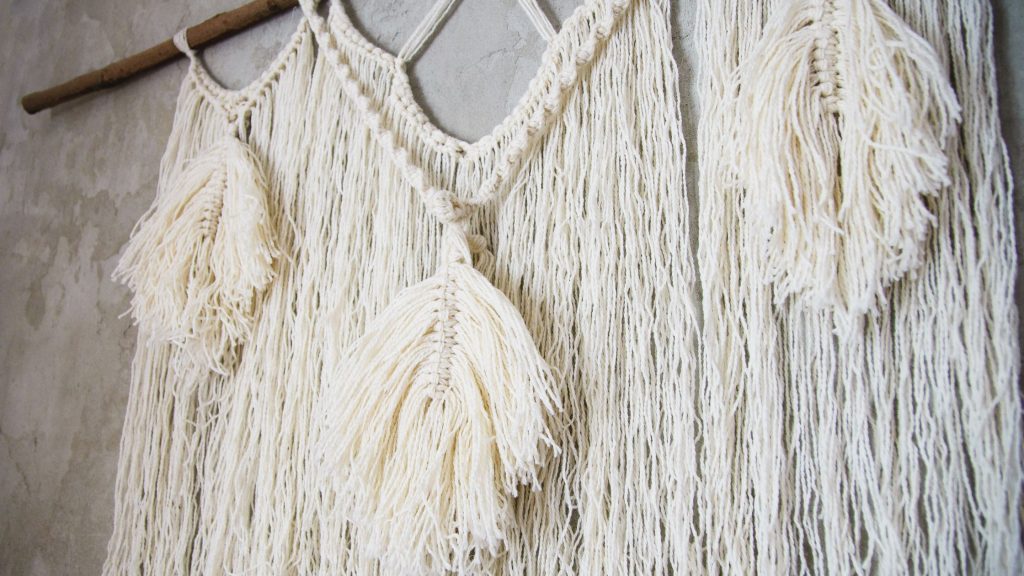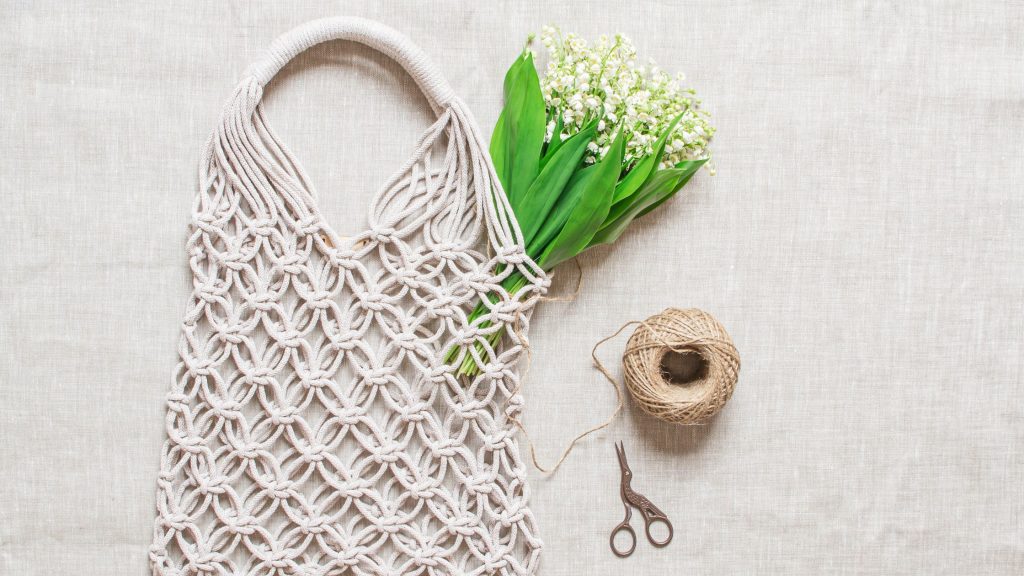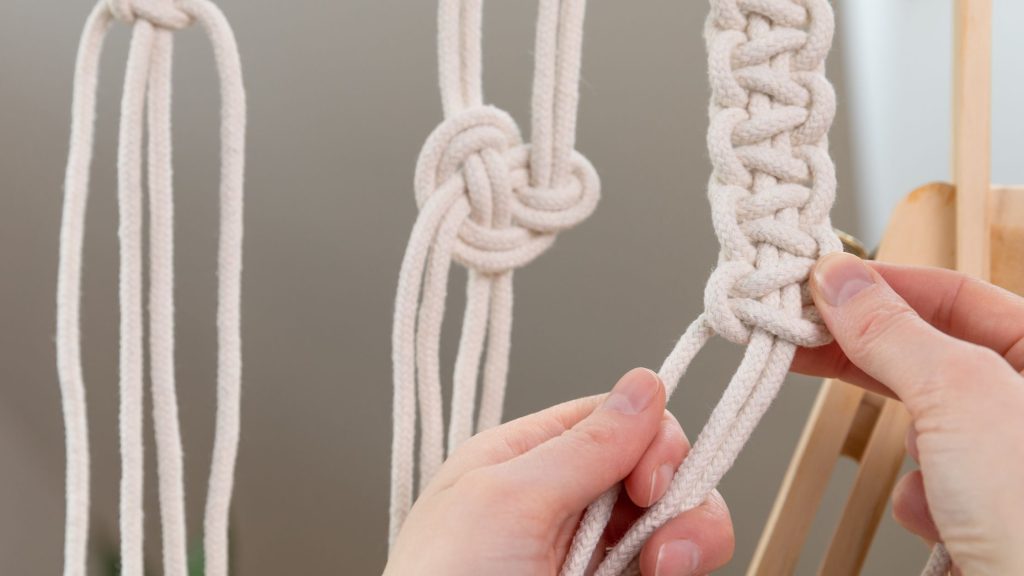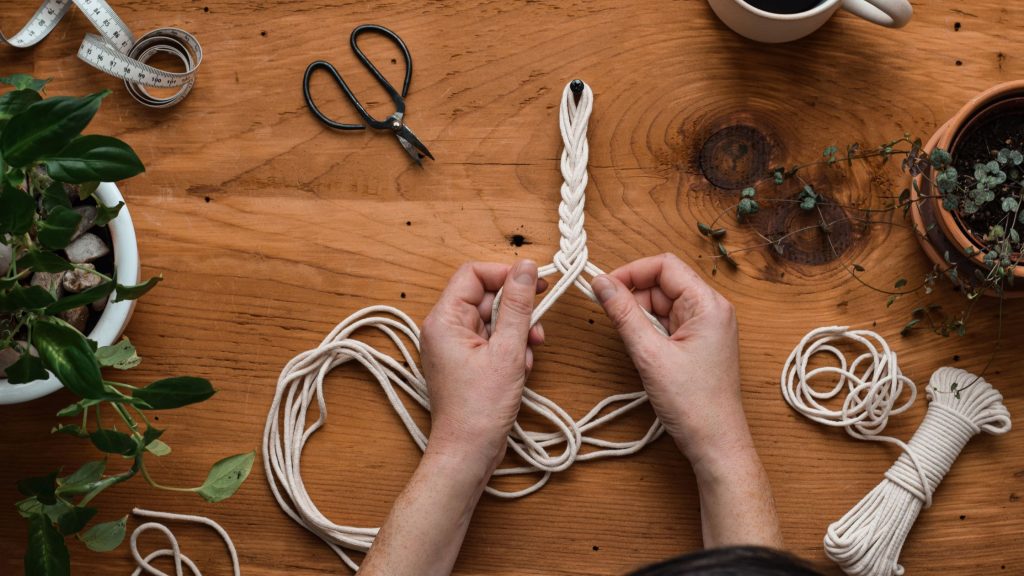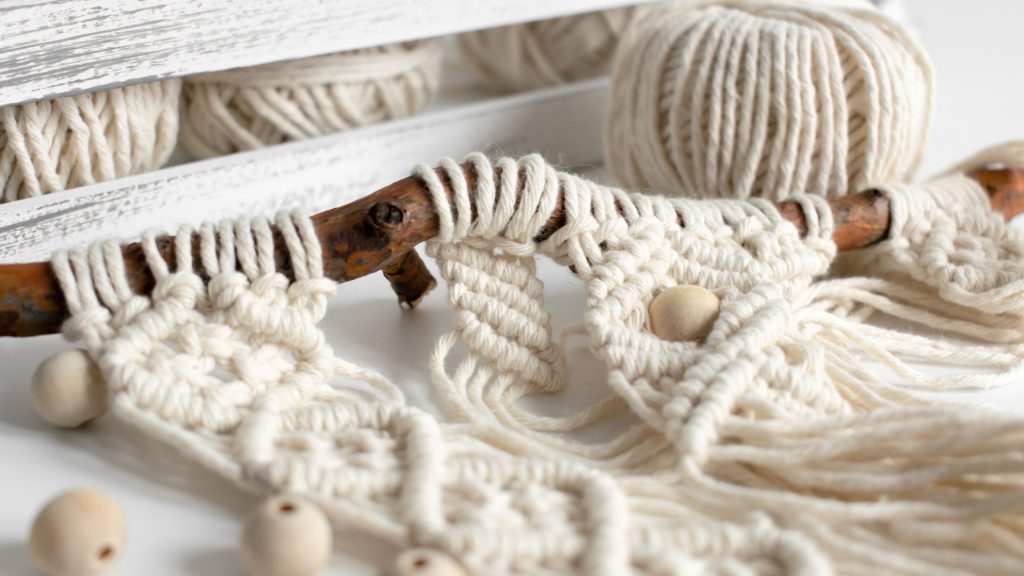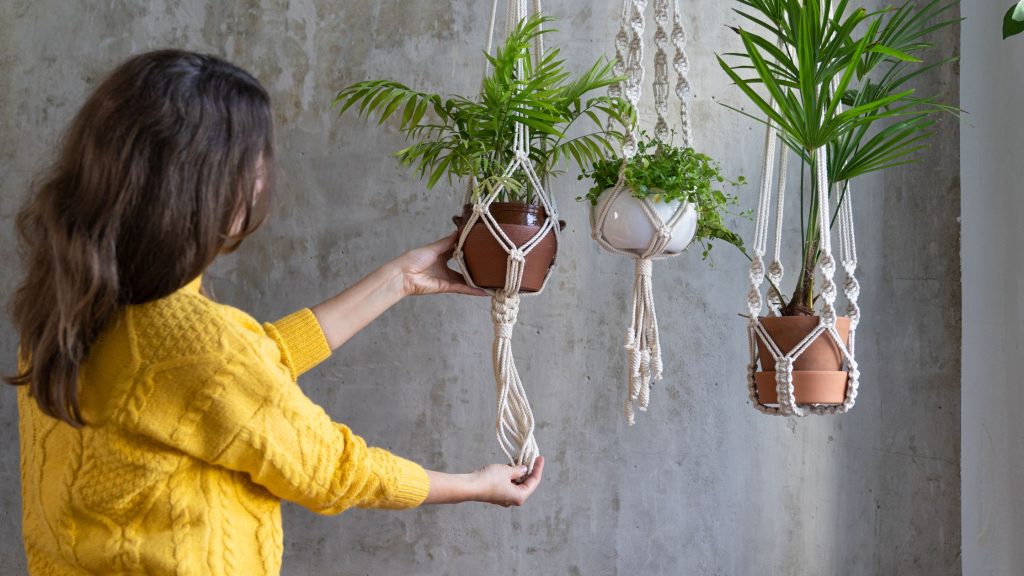Macrame is a fascinating art form that has left an indelible mark on various art forms and crafts. From its origins in the ancient Arabic world to its resurgence in popularity during the 1970s, macrame has woven its way into the fabric of creative expression. This article explores the profound influence of macrame on other artistic endeavors and crafts, showcasing its versatility and enduring impact. Whether you are a seasoned macrame enthusiast or simply curious about the interconnectedness of art forms, this exploration will shed light on the captivating story behind macrame’s influence.
Macrame as a Historic Art Form
Macrame is a time-honored art form that has captivated people for centuries. Its intricate knots and patterns have been used to create beautiful and functional pieces across different cultures and art forms. From home decor to fashion, macrame has left a lasting impression on various artistic disciplines.
The Origins of Macrame
The exact origins of macrame are still a topic of speculation, but it is believed to have originated in the Arabian Peninsula. It gained popularity in the 13th century during the Renaissance period and eventually spread to Europe. Sailors learned macrame techniques while traveling to different parts of the world, leading to its incorporation into maritime designs. Macrame then made its way to the Americas during the age of exploration, where it was adopted by Native American tribes and incorporated into their traditional crafts.
Macrame Across Different Cultures
One of the remarkable aspects of macrame is its adaptability and influence across different cultures. Each culture has incorporated its unique style and techniques, resulting in diverse macrame traditions. For example, in China, macrame is known as “Chinese knotting” and is often used for decorative purposes, particularly in the art of Feng Shui. In Japan, a technique called “kumihimo” is used to create elaborate macrame braids for clothing and accessories. Additionally, South American countries like Peru and Brazil have rich macrame traditions, utilizing vibrant colors and intricate knotting patterns in their designs.
Macrame in Interior Design
Macrame has made a significant impact on the world of interior design, offering a bohemian and natural aesthetic to any space. Through macrame plant hangers, wall hangings, and curtains, the art form has found its way into countless homes, adding a touch of handmade charm.
Macrame Plant Hangers
Macrame plant hangers have become increasingly popular in recent years, as they provide a stylish and creative way to display indoor plants. These hangers are typically made using various knots and techniques, resulting in a beautiful net-like structure that cradles the plant. Whether hanging from a ceiling hook or perched on a wall bracket, macrame plant hangers bring life to any room and create a visually pleasing focal point.
Macrame Wall Hangings
Macrame wall hangings are another popular choice for interior design enthusiasts. These intricate tapestries add texture, dimension, and a touch of bohemian charm to bare walls. From simple geometric patterns to elaborate designs with fringe and tassels, macrame wall hangings can be customized to fit any aesthetic. Whether used as a standalone art piece or as part of a gallery wall, macrame wall hangings are sure to catch the eye and create a unique ambiance in any room.
Macrame Curtains
For those wanting to make a statement with their window treatments, macrame curtains offer a stylish alternative to traditional options. These curtains are often made with macrame panels that feature delicate knots and patterns. They allow natural light to filter through while adding a touch of elegance and warmth to any space. Macrame curtains can be hung alone or layered with other window coverings to create a layered and textured look that is both functional and visually appealing.
Macrame in Fashion
Macrame is not limited to home decor alone; it has also found a place in the world of fashion. From jewelry to belts and various accessories, macrame adds a unique touch to personal style.
Macrame Jewelry
Macrame jewelry has become increasingly popular among those seeking one-of-a-kind accessories. By using various knotting techniques and incorporating different materials, artisans can create stunning pieces that showcase their creativity and craftsmanship. Macrame bracelets, necklaces, and earrings can feature intricate patterns, gemstones, beads, and unique closures, making them a statement piece that elevates any outfit.
Macrame Belts
Macrame belts offer a bohemian twist to a classic accessory. These belts are typically made with thick cords and feature intricate macrame patterns and knots. They not only add a touch of style to any outfit but also provide a comfortable and adjustable fit. Macrame belts are versatile and can be worn with dresses, tunics, or even as a waist-cinching accessory over a flowy top.
Macrame Accessories
The versatility of macrame extends beyond jewelry and belts. Various macrame accessories such as headbands, keychains, and bag charms have become popular among fashion-forward individuals. These accessories showcase the intricate knotting techniques of macrame while adding a unique touch to everyday items. Whether used to hold your keys or add a touch of style to your handbag, macrame accessories are a fun way to incorporate this ancient art form into your daily life
Macrame in Textile Design
The art of macrame has greatly influenced the world of textile design, opening up new possibilities in pattern creation and enhancing weaving techniques.
Macrame Patterns on Clothing
The incorporation of macrame patterns in clothing design has added a new level of intricacy and detail. From delicate lace-like patterns on sleeves to bold macrame panels on dresses and tops, the use of macrame adds texture and visual interest to garments. Macrame patterns on clothing can be achieved through various techniques, such as knotting cords together, creating openwork designs, or integrating macrame insets.
Macrame Techniques in Weaving
Macrame’s knotting techniques have been incorporated into weaving practices, resulting in unique fabric textures and patterns. By combining traditional weaving techniques with macrame knots, textile artisans can create intricate designs and enhance the tactile experience of the fabric. Macrame-inspired weavings offer a handmade touch to textiles, making them stand out and adding depth and dimension to any project.
Macrame in Sculpture
Macrame’s versatility extends even further, finding its way into the realm of sculpture. By utilizing various materials and blending macrame with other art forms, artists have pushed the boundaries of the medium.
Macrame and Wire
Combining macrame with wire allows artists to create sculptures that seamlessly blend fiber and metal. By incorporating macrame knots into wire structures, intricate and delicate sculptures can be formed. The contrast between the rigidness of the wire and the softness of the macrame creates a visually striking piece of art that captures the eye.
Macrame and Wood
By combining macrame with wood, artists can create sculptures that blend organic and handmade elements. The incorporation of macrame knots into wooden structures adds texture and character to the piece, turning it into a true work of art. Whether it’s a macrame-wrapped wooden branch or a web of knots secured within a wooden frame, the fusion of these materials offers a unique and visually appealing sculpture.
Macrame and Metal
Macrame and metal create a harmonious blend that results in stunning sculptures with an industrial touch. Metal structures fused with macrame knots create intriguing and unexpected contrasts, bringing together the strength of metal and the intricacy of fiber. These sculptures often explore the connection between nature, man-made materials, and craftsmanship, resulting in thought-provoking pieces that speak to the viewer.
Macrame in Jewelry Making
Macrame’s influence in the art of jewelry making has opened up a world of possibilities in the creation of unique and eye-catching pieces.
Macrame and Gemstones
By incorporating macrame knots into jewelry designs, artisans can showcase gemstones in intricate and beautiful ways. Macrame allows for the creation of adjustable bracelets, necklaces, and earrings that feature gemstones as the focal point. The combination of macrame knotting techniques and the natural beauty of gemstones creates truly captivating jewelry pieces.
Macrame and Beads
The use of beads in macrame jewelry adds an extra element of visual interest and allows for endless design possibilities. Beads can be incorporated into macrame patterns to create intricate designs or used as accents along the knots. Whether it’s a single statement bead or a pattern consisting of various beads, macrame jewelry with beadwork is sure to turn heads and add a unique touch to any outfit.
Macrame and Precious Metals
Combining macrame with precious metals elevates the art of jewelry-making to a whole new level. Macrame knots intertwined with gold, silver, or other precious metals result in exquisite pieces of wearable art. These pieces often showcase the duality of strength and delicacy, as the macrame knots contrast with the precious metal they are woven with. Macrame jewelry with precious metals is a true testament to the artistry and craftsmanship of the maker.
Macrame in Fiber Art
Macrame has long been associated with fiber art, as its knotting techniques create visually stunning pieces with a tactile appeal.
Macrame and Tapestry
Macrame techniques have been incorporated into tapestry making, allowing artisans to create intricate and three-dimensional textile pieces. By using macrame knots to create added texture and detail, tapestries come to life with depth and dimension. From wall hangings to large-scale installations, macrame tapestries attract attention and add a unique touch to any space.
Macrame and Quilting
By combining macrame with the art of quilting, artisans can create quilts with an added layer of texture and intricacy. Macrame knots can be incorporated as appliques or built directly into the quilting design, creating striking patterns and visual interest. The fusion of macrame and quilting extends the possibilities of this traditional craft and breathes new life into quilted textiles.
Macrame and Embroidery
Macrame and embroidery complement each other beautifully, with macrame adding dimension and texture to embroidered pieces. By incorporating macrame knots into embroidered designs, artists can create unique and visually captivating textile art. The combination of these techniques allows for the creation of intricate patterns and adds a tactile appeal to embroidered pieces.
Macrame in Home Decor
Macrame has become synonymous with bohemian-style home decor, offering a natural and handmade aesthetic that adds warmth and character to any space.
Macrame Lampshades
Macrame lampshades provide a warm and inviting ambiance to any room. Whether hung as a pendant or used to cover a table lamp, these shades create captivating patterns of light and shadow. The intricate macrame knots allow for the diffusion of light, casting beautiful patterns on surrounding surfaces. Macrame lampshades are a perfect way to add a touch of artistic elegance to any interior space.
Macrame Table Runners
Macrame table runners add a unique and handmade touch to any dining table or console. These runners, often made with intricate knotting patterns, create a beautiful backdrop for table settings and centerpieces. With their delicate details, macrame table runners bring a sense of craftsmanship and charm to any gathering.
Macrame Pillows
Macrame pillows offer a cozy and stylish addition to any seating area. Made with soft cords and intricate macrame patterns, these pillows provide both tactile and visual appeal. Whether used as throw pillows on a couch or as decorative accents on a bed, macrame pillows create a warm and inviting atmosphere in any space.
Macrame in Pottery and Ceramics
Macrame’s influence extends beyond textiles and fibers, making its way into the world of pottery and ceramics.
Macrame-inspired Pottery Handles
Incorporating macrame-inspired handles on pottery pieces adds a unique and functional touch. The use of macrame knots and techniques in creating handles allows for a comfortable grip and adds a decorative element to the pottery. Whether it’s on a mug, vase, or teapot, macrame-inspired pottery handles enhance the overall aesthetic and functionality of the piece.
Macrame and Ceramic Wall Art
By combining macrame with ceramics, artists can create stunning wall art pieces that blend different textures and materials. Ceramic wall art with woven macrame elements offers a juxtaposition of rigidity and softness, creating a visually captivating piece. These sculptures often explore themes of nature, culture, and craftsmanship, creating a meaningful and artistic addition to any space.
Macrame in Contemporary Art
Macrame’s influence is not limited to traditional art forms; it has found its way into contemporary art, pushing boundaries and exploring new possibilities.
Macrame Installations
Macrame installations have become a powerful means of artistic expression. By using macrame knots and techniques, artists can create large-scale pieces that transform the spaces they occupy. Macrame installations often explore themes of identity, culture, and environmental consciousness, inviting viewers to engage with the art and their surroundings in a new way.
Macrame in Mixed Media Art
Incorporating macrame into mixed media art allows for the combination of various materials, textures, and techniques. Whether it’s adding macrame elements to a painting, sculpture, or collage, the infusion of macrame adds depth, dimension, and a tactile experience to the artwork. Mixed media art with macrame breaks boundaries and blurs the lines between different artistic disciplines, creating visually striking and thought-provoking pieces.
Conclusion
In conclusion, macrame has proven to be a versatile and influential art form that has left its mark on various artistic disciplines. From interior design to fashion, textile design to sculpture, macrame’s intricate knots and patterns continue to inspire and captivate artists and enthusiasts around the world. With its rich history and timeless appeal, macrame will undoubtedly continue to influence and shape the world of art and crafts for years to come.


